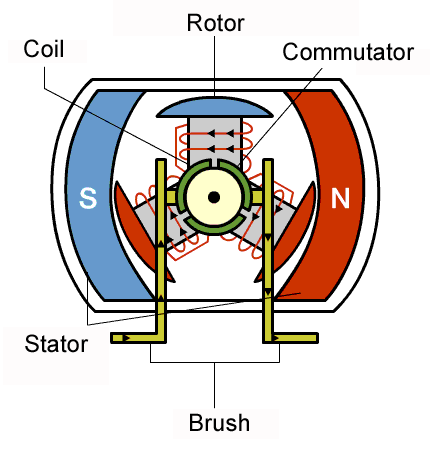Motors: KT & KV

If you pick up the data sheet for a motor, one of the first things you'll see are the and ratings.
A lot of motors even have these values written on the rotor.
But what do they mean?
1. The Relationship Between Torque & Current
Electric motors convert electrical energy into mechanical energy, with torque being the force that causes rotation.
In a simplified DC motor model, the generated torque is directly proportional to the armature current :
where:
- is the torque (in Newton-meters, N·m),
- is the current (in Amperes, A),
- is the torque constant (in N·m/A).
This equation indicates that for every ampere of current, the motor produces a proportional amount of torque as determined by .
2. The Relationship Between Speed & Voltage
The motor’s speed—typically measured as the angular velocity (in radians per second) or in revolutions per minute (rpm)—is primarily governed by the voltage applied to the motor. As the motor spins, it generates a back electromotive force (back EMF) that is proportional to its speed:
where:
- is the applied voltage (in Volts, V),
- is the angular velocity (in rad/s),
- is the back EMF constant (in V/(rad/s)).
Under no-load conditions, the back EMF nearly equals the applied voltage, linking voltage directly to speed.
3. Introducing and
: The Motor Velocity Constant
- Definition: is typically expressed as the number of revolutions per minute (rpm) the motor achieves per volt under no load.
- Units: rpm/V.
- Interpretation: For instance, if a motor has a of 1000 rpm/V, applying 1 volt ideally produces 1000 rpm, and 10 volts yield 10,000 rpm.
: The Motor Torque Constant
- Definition: represents the torque produced per ampere of current.
- Units: N·m/A.
- Interpretation: A motor with a of 0.05 N·m/A will generate 0.05 N·m of torque for every 1 ampere of current.
In ideal motors using SI units, the back EMF constant and the torque constant are numerically equal, reflecting energy conservation within the motor.
4. Deriving the Relationship Between and
4.1 Converting to SI-Compatible Units
is typically given in rpm/V, but for consistency with SI units (where angular velocity is in rad/s), we need to convert:
If the motor’s speed per volt is rpm/V, then in SI units the speed per volt becomes:
4.2 Relating Back EMF to Motor Speed
The back EMF generated in the motor is given by:
Under no-load conditions, the applied voltage almost equals the back EMF:
Thus, for a given voltage, the speed is approximately:
Considering the SI conversion, where the no-load speed per volt is :
By canceling (assuming ), we obtain:
Replacing with the converted form gives:
4.3 Establishing the Relationship with
For an ideal motor, energy conservation dictates that the electrical power equals the mechanical power (ignoring losses):
Substitute the expressions and :
Canceling and (assuming they are non-zero):
Given the earlier result for , it follows that:
5. Okay... So what?
The main equation care about is this one,
All this equation is saying is that there's a tradeoff between and .
And since is proportional to torque and is proportional to speed, then there is a fundamental tradeoff between torque and speed. We can't just increase or decrease both.
